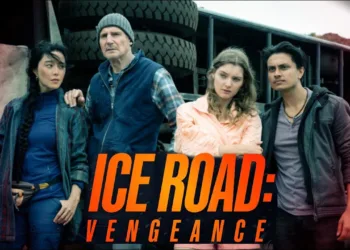Five decades ago, Steven Spielberg changed cinema forever with a malfunctioning mechanical shark and a two-note musical motif that still makes beachgoers nervous. Laurent Bouzereau’s “Jaws @ 50: The Definitive Inside Story” arrives as both celebration and archaeological dig, examining how a troubled production became the template for modern moviemaking. Bouzereau, whose documentary expertise spans from “Music by John Williams” to countless Spielberg retrospectives, brings the perfect sensibility to this project—part film historian, part cultural anthropologist.
The National Geographic production benefits from extraordinary access, featuring candid conversations with Spielberg himself alongside a murderer’s row of contemporary filmmakers who grew up in Jaws’ shadow. What emerges in these lean 90 minutes isn’t just another making-of documentary, but a fascinating study of how artistic accidents can reshape entire industries.
The film traces Peter Benchley’s novel from conception through its transformation into cinema’s first true summer blockbuster, revealing how a young director’s nightmare shoot became his greatest triumph. Bouzereau understands that Jaws represents a cultural watershed—the moment when Hollywood discovered it could turn summer into a season of spectacle.
When Everything Goes Wrong: The Beautiful Chaos of Filmmaking
The production stories here feel like disaster movie folklore, and Bouzereau presents them with the right mix of reverence and bewilderment. Watching Spielberg reflect on his 20-something self, barely three films into his career, grappling with an oceanic shoot that seemed cursed from day one, you’re struck by how many variables had to align for cinema history to happen. The mechanical shark “Bruce” becomes almost a character in its own right—a temperamental star whose constant breakdowns forced creative solutions that accidentally perfected the art of cinematic terror.
Martha’s Vineyard emerges as more than just a location; it’s a character with its own agency. The documentary captures how this quiet New England community became complicit in creating movie magic, with locals transforming into extras and the island itself becoming Amity. These aren’t just production anecdotes—they’re insights into how great films often emerge from embracing rather than fighting their limitations.
When Spielberg couldn’t show his shark, John Williams’ score filled the void, creating atmosphere through absence rather than presence. The documentary excels at showing how technical constraints can become artistic strengths, a lesson that feels especially relevant in our CGI-saturated era.
The archival footage here is remarkable—grainy 16mm glimpses of a film crew fighting the elements, personal moments between takes that reveal the human cost of artistic ambition. Bouzereau has always understood that great filmmaking documentaries aren’t just about the final product, but about the messy, unpredictable process of creation.
Voices Across Time: The Living Legacy of a Classic
What sets this documentary apart is its democratic approach to storytelling. Richard Dreyfuss shares screen time with Jeffrey Voorhees, the child actor who played Alex Kintner, and both perspectives carry equal weight. This isn’t hagiography—it’s a genuine exploration of how a single film can ripple through multiple lives across decades.
The Martha’s Vineyard locals who found themselves part of cinema history speak with the same authority as the Hollywood heavyweights, and Bouzereau’s editing makes this feel natural rather than forced. The contemporary filmmaker interviews provide the documentary’s most compelling insights. Jordan Peele’s analysis of Jaws’ opening sequence reveals how Spielberg’s techniques continue to influence modern horror.
James Cameron and Guillermo del Toro speak as craftsmen recognizing a master’s work, while Steven Soderbergh’s enthusiasm for Spielberg’s guerrilla tactics shows how the film’s rebellious spirit continues to inspire. These aren’t just talking heads offering platitudes—they’re artists dissecting technique, showing how Jaws’ DNA lives on in everything from “Nope” to “The Shape of Water.”
The documentary’s treatment of Peter Benchley feels particularly thoughtful. Rather than treating him as a footnote to Spielberg’s genius, Bouzereau positions him as the essential catalyst, showing how the author’s Long Island fishing experiences and encounter with “Blue Water, White Death” sparked the entire phenomenon. The glimpse of Benchley’s title brainstorming session—dozens of rejected options scrawled on paper—reminds us how precarious creative breakthroughs can be.
Cultural Artifact: How a Shark Movie Rewrote the Rules
Bouzereau’s greatest achievement is contextualizing Jaws within the broader cultural moment of mid-70s America. The film arrived during a period of institutional distrust—post-Watergate, mid-Vietnam—and its themes of civic corruption and denial resonated beyond its creature feature surface. The documentary doesn’t belabor these connections, but it acknowledges them, showing how great popular entertainment often works as cultural therapy.
The environmental discussion adds necessary complexity to the celebration. Jaws inadvertently triggered decades of shark hunting, a real-world consequence that the documentary addresses without diminishing the film’s artistic achievement. This balance—acknowledging both the film’s inspiration of marine biologists and its role in demonizing an entire species—exemplifies Bouzereau’s mature approach to his subject.
The documentary’s structure mirrors its subject’s efficiency. At 90 minutes, it never feels rushed or superficial, instead maintaining the tight pacing that made Jaws itself so effective. Bouzereau presents familiar material with fresh eyes, using his unprecedented access to archival materials and personal footage to create something that feels both comprehensive and intimate.
For longtime fans, it offers new details and perspectives; for newcomers, it provides perfect entry into understanding why this particular film continues to matter. The result is a documentary that functions as both historical record and love letter, proving that some stories deserve to be told again and again, especially when they’re told this well.
“Jaws @ 50: The Definitive Inside Story” is a documentary that explores the making and legacy of the iconic 1975 film “Jaws.” The documentary features new interviews with director Steven Spielberg, as well as original cast and crew members. The documentary premieres on National Geographic on July 10, 2025, and will be available to stream on Disney+ and Hulu the following day.
Full Credits
Director: Laurent Bouzereau
Writers: Information not available.
Producers: Darryl Frank, Justin Falvey, Laurent Bouzereau, Markus Keith
Executive Producers: Wendy Benchley, Laura Bowling, Tracy Rudolph Jackson, Ted Duvall
Cast: Steven Spielberg, Joe Alves, Jonathan Filley, Lorraine Gary, Carl Gottlieb, Jeffrey Kramer, Jeffrey Voorhees, John Williams, J.J. Abrams, Emily Blunt, James Cameron, Cameron Crowe, George Lucas, Greg Nicotero, Jordan Peele, Steven Soderbergh, Guillermo del Toro, Robert Zemeckis
Composer: John Williams
The Review
Jaws @ 50: The Definitive Inside Story
Bouzereau has crafted the definitive retrospective on cinema's most influential blockbuster. Through exceptional archival access and thoughtful curation, "Jaws @ 50" transforms familiar behind-the-scenes lore into essential viewing. The documentary succeeds as both nostalgic celebration and serious film scholarship, offering fresh insights while honoring the chaotic artistry that created a masterpiece. For anyone interested in filmmaking, cultural history, or simply great storytelling, this is indispensable.
PROS
- Exceptional archival footage and unprecedented access
- Balances multiple perspectives from cast, crew, and contemporary filmmakers
- Tight 90-minute runtime maintains perfect pacing
- Treats all contributors with equal respect and dignity
- Provides fresh insights into well-known production stories
CONS
- Environmental impact discussion feels slightly underdeveloped
- Some contemporary filmmaker segments feel brief
- Could have explored more technical filmmaking details














































